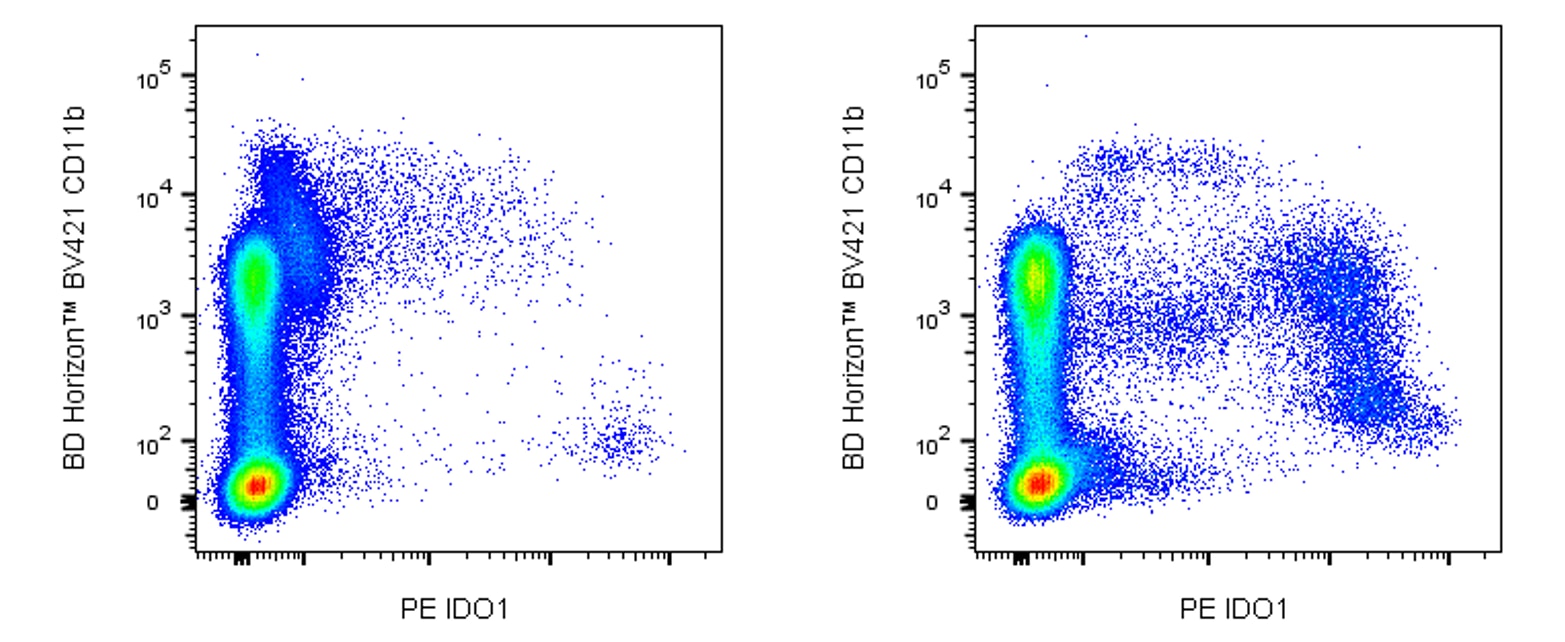Old Browser
This page has been recently translated and is available in French now.
Looks like you're visiting us from {countryName}.
Would you like to stay on the current country site or be switched to your country?


.png)

Multicolor flow cytometric analysis of IDO1 expression on human peripheral blood mononuclear cells (PBMCs). PBMCs were cultured in complete tissue culture medium without (Left Plot) or with (Right Plot) lipopolysaccharide (LPS) (1 ug/ml, 20-24h, 37°C). The cells were harvested, then fixed and permeabilized using BD Cytofix/Cytoperm™ solution (Cat. No. 554722) and BD Perm/Wash™ buffer (Cat. No. 554723). The cells were then stained with BD Horizon™ BV421 Mouse Anti-Human CD11b (Cat. No. 562632) and PE Mouse Anti-Human IDO1 antibody (Cat. No. 567867/567868). Bivariate pseudocolor density plots showing the correlated expression of IDO1 (or Ig Isotype control staining) versus CD11b were derived from gated events with the forward and side light-scatter characteristics of intact PBMCs. Flow cytometric analysis was performed using a BD LSRFortessa™ X-20 Flow Cytometer System.
.png)

BD Pharmingen™ PE Mouse Anti-Human IDO1
.png)
Regulatory Status Legend
Any use of products other than the permitted use without the express written authorization of Becton, Dickinson and Company is strictly prohibited.
Preparation And Storage
Recommended Assay Procedures
BD® CompBeads can be used as surrogates to assess fluorescence spillover (Compensation). When fluorochrome conjugated antibodies are bound to BD® CompBeads, they have spectral properties very similar to cells. However, for some fluorochromes there can be small differences in spectral emissions compared to cells, resulting in spillover values that differ when compared to biological controls. It is strongly recommended that when using a reagent for the first time, users compare the spillover on cells and BD® CompBeads to ensure that BD® CompBeads are appropriate for your specific cellular application.
Product Notices
- Please refer to www.bdbiosciences.com/us/s/resources for technical protocols.
- Source of all serum proteins is from USDA inspected abattoirs located in the United States.
- Caution: Sodium azide yields highly toxic hydrazoic acid under acidic conditions. Dilute azide compounds in running water before discarding to avoid accumulation of potentially explosive deposits in plumbing.
- This reagent has been pre-diluted for use at the recommended Volume per Test. We typically use 1 × 10^6 cells in a 100-µl experimental sample (a test).
- An isotype control should be used at the same concentration as the antibody of interest.
- For fluorochrome spectra and suitable instrument settings, please refer to our Multicolor Flow Cytometry web page at www.bdbiosciences.com/colors.
- Please refer to http://regdocs.bd.com to access safety data sheets (SDS).
Companion Products


The V50-1886 monoclonal antibody specifically binds to human IDO1, or indoleamine 2, 3-dioxygenase 1, a rate-limiting enzyme in the catabolism of tryptophan. IDO1 is expressed in normal epithelial, endothelial and myeloid cells and in tumor cells. Its expression is induced by interferon gamma and increases in viral and bacterial infections. The reduction of tryptophan and increase in its metabolites that are mediated by IDO1 have critical immunosuppressive and bactericidal effects.

Development References (6)
-
Liu H, Shen Z, Wang Z, et al. Increased expression of IDO associates with poor postoperative clinical outcome of patients with gastric adenocarcinoma.. Sci Rep. 2016; 6:21319. (Biology). View Reference
-
Nakamura T1, Shima T, Saeki A, et al. Expression of indoleamine 2, 3-dioxygenase and the recruitment of Foxp3-expressing regulatory T cells in the development and progression of uterine cervical cancer.. 2007; 98(6):874-881. (Biology). View Reference
-
Takikawa O1, Kuroiwa T, Yamazaki F, Kido R.. Mechanism of interferon-gamma action. Characterization of indoleamine 2,3-dioxygenase in cultured human cells induced by interferon-gamma and evaluation of the enzyme-mediated tryptophan degradation in its anticellular activity.. J Biol Chem. 1988; 263(4):2041-2048. (Biology). View Reference
-
Théate I, van Baren N, Pilotte L, et al. Extensive profiling of the expression of the indoleamine 2,3-dioxygenase 1 protein in normal and tumoral human tissues.. Cancer Immunol Res. 2015; 3(2):161-72. (Biology). View Reference
-
Zamorina SA, Timganova VP, Bochkova MS, Khramtsov PV, Raev MB. Effect of pregnancy-specific β1-glycoprotein on indoleamine-2,3-dioxygenase activity in human monocytes.. Dokl Biol Sci. 2016; 469(1):206-8. (Biology). View Reference
-
van Baren N, Van den Eynde BJ. Tryptophan-degrading enzymes in tumoral immune resistance.. Front Immunol. 2015; 6:34. (Biology). View Reference
Please refer to Support Documents for Quality Certificates
Global - Refer to manufacturer's instructions for use and related User Manuals and Technical data sheets before using this products as described
Comparisons, where applicable, are made against older BD Technology, manual methods or are general performance claims. Comparisons are not made against non-BD technologies, unless otherwise noted.
For Research Use Only. Not for use in diagnostic or therapeutic procedures.
Report a Site Issue
This form is intended to help us improve our website experience. For other support, please visit our Contact Us page.